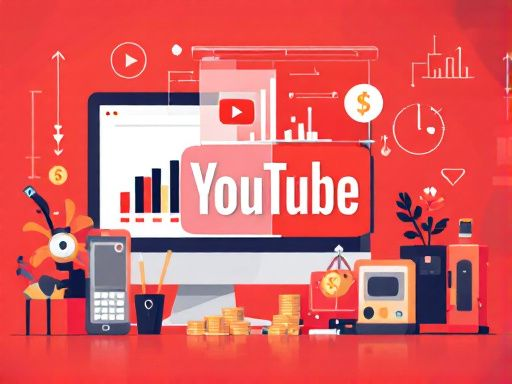Understanding YouTube’s Monetization Model
YouTube’s Partner Program (YPP) is a vital component of the platform’s ecosystem, allowing creators to monetize their content and earn revenue from their videos. To be eligible for the YPP, a channel must have at least 1,000 subscribers and 4,000 watch hours in the past 12 months. Once a channel meets these requirements, it can apply for the YPP and start displaying ads on its videos.
YouTube’s monetization model is based on a cost-per-click (CPC) and cost-per-thousand impressions (CPM) system. Advertisers pay YouTube to display their ads on videos, and creators earn a portion of the revenue generated by these ads. The amount of money a creator earns from a video depends on several factors, including the number of views, clicks, and engagement. This raises an important question: how much does YouTube pay for 1 million views? The answer to this question is complex and depends on various factors, including the niche or topic of the video, audience engagement, and the number of subscribers.
YouTube’s algorithm plays a crucial role in determining video visibility and earnings. The algorithm favors videos that are high-quality, engaging, and relevant to the audience. Creators can optimize their videos for the algorithm by using relevant keywords, tags, and descriptions. They can also promote their videos on social media and engage with their audience to increase their visibility and earnings.
YouTube takes a 45% cut of the ad revenue generated by videos, and creators receive the remaining 55%. The amount of money a creator earns from a video also depends on the type of ads displayed. For example, video ads tend to generate more revenue than display ads. Additionally, creators can earn more money from ads if they have a high click-through rate (CTR) and conversion rate.
Understanding YouTube’s monetization model is essential for creators who want to earn revenue from their videos. By optimizing their videos for the algorithm, promoting their content on social media, and engaging with their audience, creators can increase their earnings and build a successful YouTube channel. In the next section, we will explore tips and strategies for maximizing YouTube earnings and provide more insights into how much YouTube pays for 1 million views.
How to Maximize Your YouTube Earnings
Maximizing YouTube earnings requires a strategic approach to video optimization, audience engagement, and monetization. While understanding how much YouTube pays for 1 million views is crucial, it is equally important to focus on creating high-quality content that resonates with viewers. Here are some tips to help increase YouTube earnings:
Optimizing video titles, descriptions, and tags is essential for improving video visibility and earnings. Craft attention-grabbing titles that accurately reflect the content, and include relevant keywords to enhance search engine rankings. Use descriptive and concise descriptions to provide context, and add relevant tags to help viewers find the video.
Eye-catching thumbnails are also vital for capturing viewers’ attention and increasing click-through rates. Create visually appealing thumbnails that showcase the main topic or highlight of the video, and ensure they are optimized for various devices and platforms.
Promoting videos on social media is another effective way to increase visibility and earnings. Share videos on Facebook, Twitter, Instagram, and other platforms to reach a broader audience, and engage with viewers by responding to comments and creating a community around the content.
Audience engagement, watch time, and retention are critical factors in boosting ad revenue. Focus on creating high-quality, engaging content that encourages viewers to watch until the end, and interact with them through comments, live streams, and Q&A sessions.
Additionally, leveraging YouTube Analytics can help creators identify areas for improvement and optimize their content for better performance. By analyzing metrics such as views, engagement, and earnings, creators can refine their strategy and increase their YouTube earnings.
While understanding how much YouTube pays for 1 million views is essential, it is equally important to focus on creating a loyal audience and building a community around the content. By providing value and usefulness to viewers, creators can increase their earnings and achieve long-term success on the platform.
The Cost of a Million Views: Breaking Down YouTube’s Payment Structure
Understanding how much YouTube pays for 1 million views requires a deep dive into the platform’s payment structure. YouTube’s Partner Program (YPP) uses a cost-per-click (CPC) and cost-per-thousand impressions (CPM) model to calculate earnings from ads. The CPC model pays creators for each ad click, while the CPM model pays for every 1,000 ad impressions.
YouTube takes a 45% cut of the ad revenue, leaving creators with 55% of the earnings. The platform also uses a complex algorithm to determine which ads to display on each video, taking into account factors such as viewer demographics, ad relevance, and video content. This algorithm affects not only the types of ads displayed but also the earnings per 1,000 views.
Estimating the average earnings per 1,000 views is challenging, as it varies greatly depending on the niche, audience engagement, and ad relevance. However, according to various reports, the average CPM for YouTube ads ranges from $0.50 to $5.00. This translates to earnings of $500 to $5,000 per 1 million views, assuming an average CPM of $2.50.
It’s essential to note that these estimates are based on averages and may not reflect actual earnings. Many factors can influence ad revenue, such as viewer engagement, watch time, and ad click-through rates. Creators can increase their earnings by optimizing their videos for better ad placement, using eye-catching thumbnails, and promoting their content on social media.
To give you a better idea of how much YouTube pays for 1 million views, let’s consider a hypothetical scenario. Assume a creator has a video with 1 million views, an average CPM of $2.50, and an ad click-through rate of 0.5%. Based on these numbers, the creator could earn approximately $2,500 from ads alone. However, this amount may vary depending on the actual ad revenue and YouTube’s 45% cut.
In conclusion, understanding YouTube’s payment structure is crucial for creators looking to maximize their earnings. By knowing how much YouTube pays for 1 million views, creators can optimize their content, engage with their audience, and diversify their income streams to increase their overall earnings.
Factors Affecting YouTube Earnings: From Niche to Audience Engagement
When it comes to understanding how much YouTube pays for 1 million views, several factors come into play. The niche or topic of the video is a crucial determinant of earnings. Certain niches, such as finance, technology, and gaming, tend to attract high-paying advertisers, resulting in higher earnings per view. On the other hand, niches with lower advertiser demand, such as vlogging or lifestyle content, may generate lower earnings.
Audience engagement is another critical factor that affects YouTube earnings. Videos that encourage viewers to like, comment, and share tend to perform better in terms of ad revenue. This is because engaged viewers are more likely to watch ads and interact with them, increasing the chances of earning revenue. Additionally, YouTube’s algorithm favors videos with high engagement, making them more visible to a broader audience.
Watch time is also an essential factor in determining YouTube earnings. Videos that keep viewers engaged for longer periods tend to generate more ad revenue. This is because longer watch times provide more opportunities for ads to be displayed, increasing the chances of earning revenue. Furthermore, YouTube’s algorithm rewards videos with high watch times, making them more likely to appear in search results and recommendations.
The number of subscribers is another factor that affects YouTube earnings. Channels with a large and loyal subscriber base tend to generate more ad revenue. This is because subscribers are more likely to watch and engage with videos, increasing the chances of earning revenue. Additionally, YouTube’s algorithm favors channels with a strong subscriber base, making them more visible to a broader audience.
Other factors that affect YouTube earnings include the type of ads displayed, the viewer’s location, and the time of year. For example, ads displayed during peak holiday seasons tend to generate more revenue than those displayed during off-peak seasons. Understanding these factors can help creators optimize their content and monetization strategies to maximize their earnings.
By understanding the factors that affect YouTube earnings, creators can develop strategies to increase their revenue. For example, creators can focus on creating content that resonates with their audience, encouraging engagement and watch time. They can also experiment with different ad formats and placements to maximize their earnings. By doing so, creators can unlock their YouTube earning potential and increase their revenue over time.
Real-Life Examples: How Much Do YouTubers Earn from 1 Million Views?
While understanding YouTube’s monetization model and optimizing videos for maximum earnings are crucial, examining real-life examples of successful YouTubers can provide valuable insights into the potential earnings from 1 million views. The amount YouTube pays for 1 million views varies greatly depending on factors such as niche, audience engagement, and monetization strategies.
For instance, a popular gaming YouTuber with a large following and high engagement may earn significantly more from 1 million views than a vlogger with a smaller audience. According to estimates, a gaming YouTuber can earn between $2,000 to $5,000 from 1 million views, while a vlogger may earn around $1,000 to $2,000.
Another example is a beauty YouTuber who has partnered with popular brands to promote their products in her videos. With an average CPM of $10 and a high click-through rate, she can earn around $3,000 to $6,000 from 1 million views. In contrast, a YouTuber who focuses on educational content may earn lower CPMs, around $2 to $5, resulting in earnings of $1,000 to $2,500 from 1 million views.
It’s essential to note that these estimates are based on various factors, including the YouTuber’s niche, audience engagement, and monetization strategies. Additionally, YouTube’s algorithm favors videos that perform well in terms of watch time, engagement, and audience retention, which can significantly impact earnings.
While the exact amount YouTube pays for 1 million views is difficult to determine, these real-life examples demonstrate the potential earnings for successful YouTubers. By understanding the factors that contribute to their success, creators can develop effective strategies to increase their earnings and unlock their YouTube earning potential.
Ultimately, the key to maximizing earnings on YouTube is to create high-quality, engaging content that resonates with audiences and leverages effective monetization strategies. By examining the success of popular YouTubers and incorporating innovative and creative concepts into their content, creators can increase their chances of success and earn significant amounts from their videos, including the coveted 1 million views milestone.
Monetization Strategies Beyond AdSense: Sponsorships, Merchandise, and More
While understanding how much YouTube pays for 1 million views is crucial for creators, relying solely on AdSense can limit their earning potential. To maximize revenue, YouTubers can explore alternative monetization strategies that cater to their unique audience and niche.
Sponsorships and product placements are effective ways to earn money from YouTube videos. By partnering with brands, creators can promote products or services that align with their content and values, earning money from each sale or referral made through their unique affiliate link. This approach not only generates revenue but also adds credibility to the creator’s brand.
Merchandise sales are another lucrative option for YouTubers. By designing and selling branded merchandise, such as t-shirts, hats, or accessories, creators can monetize their audience’s loyalty and enthusiasm. This strategy works particularly well for creators with a strong brand identity and engaged community.
Affiliate marketing is another way to earn money from YouTube videos. By promoting products or services from other companies and including affiliate links in their videos or video descriptions, creators can earn a commission for each sale made through their unique link. This approach requires minimal effort and can generate significant revenue, especially for creators with a large and engaged audience.
Membership programs are also gaining popularity among YouTubers. By offering exclusive content, early access, or behind-the-scenes footage, creators can entice their audience to join a membership program, generating recurring revenue and fostering a loyal community.
To succeed with these alternative monetization strategies, creators must understand their audience’s needs and preferences. By providing value and relevance, creators can build trust and loyalty, increasing the likelihood of their audience engaging with sponsored content, buying merchandise, or joining a membership program.
Ultimately, diversifying income streams is crucial for YouTubers seeking to maximize their earnings. By exploring alternative monetization strategies and understanding how much YouTube pays for 1 million views, creators can unlock their full earning potential and build a sustainable career on the platform.
Optimizing Your YouTube Channel for Maximum Earnings
When it comes to maximizing YouTube earnings, optimization plays a crucial role. By fine-tuning various aspects of a YouTube channel, creators can increase their chances of earning more from their videos, including understanding how much YouTube pays for 1 million views. To start, it’s essential to focus on video formatting, ensuring that each video is well-structured, concise, and engaging.
Titles, descriptions, and tags are also vital components of YouTube optimization. Craft attention-grabbing titles that accurately reflect the content of the video, while also incorporating relevant keywords to improve discoverability. Descriptions should provide a brief summary of the video, including links to external resources or social media profiles. Tags, on the other hand, help YouTube’s algorithm understand the content and context of the video, making it more likely to appear in search results.
Consistency is key to building a loyal audience and increasing earnings on YouTube. Regularly posting high-quality content helps to establish a channel’s authority and credibility, making it more attractive to viewers and advertisers alike. Additionally, engaging with the audience through comments, social media, and live streams can help to foster a sense of community, leading to increased watch time, engagement, and ultimately, earnings.
Another critical aspect of optimization is audience retention. Creators should focus on crafting content that resonates with their audience, keeping them engaged throughout the video. This can be achieved by using a mix of visuals, animations, and storytelling techniques to make the content more compelling and interactive. By analyzing audience retention metrics, creators can identify areas for improvement and adjust their content strategy accordingly.
Finally, community building is essential for long-term success on YouTube. By creating a loyal following, creators can increase their earnings through merchandise sales, sponsorships, and memberships. Engaging with the audience, responding to comments, and acknowledging feedback can help to build trust and loyalty, leading to a more sustainable and profitable YouTube channel. By incorporating these optimization strategies, creators can unlock their YouTube earning potential and increase their chances of success in the ever-competitive world of online video content.
Conclusion: Unlocking Your YouTube Earning Potential
Maximizing YouTube earnings requires a deep understanding of the platform’s monetization model, as well as strategies to boost engagement, audience retention, and watch time. By optimizing video titles, descriptions, and tags, using eye-catching thumbnails, and promoting videos on social media, creators can increase their ad revenue and earn more from their content. Additionally, diversifying income streams through sponsorships, merchandise sales, affiliate marketing, and memberships can help creators unlock their full earning potential on YouTube.
While the question of how much YouTube pays for 1 million views is a common one, the answer depends on a variety of factors, including the niche or topic of the video, audience engagement, watch time, and the number of subscribers. By focusing on creating high-quality, engaging content that resonates with their audience, creators can increase their earnings and build a successful YouTube channel. By experimenting with different strategies and staying up-to-date with the latest trends and best practices, creators can unlock their YouTube earning potential and achieve long-term success on the platform.



